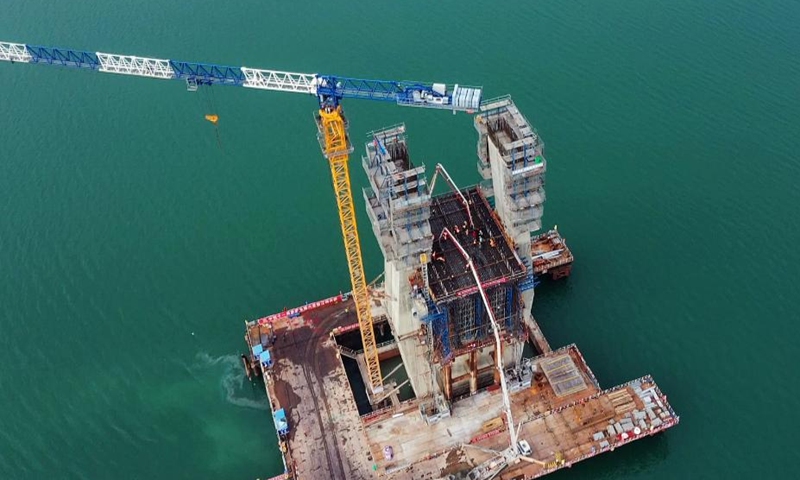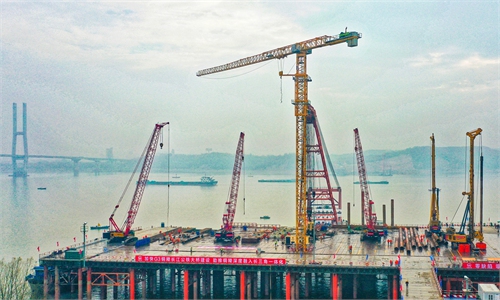
Aerial photo taken on Jan. 11, 2022 shows the construction site of the high-speed railway linking Nanning and Yulin of south China's Guangxi Zhuang Autonomous Region.(Photo: Xinhua)
With major infrastructure projects kicking off in early 2022 across multiple provinces in China, fixed-asset investment is on a fast track, which expected to drive economic growth as the world's second-largest economy aims to stabilize GDP rates amid rising challenges, experts said.
As of Wednesday, Central China's Hubei Province, East China's Fujian Province, North China's Shaanxi Province and other provinces had held ground-breaking ceremonies for key construction projects, the majority of which are infrastructure ones.
On February 8, Southwest China's Chongqing and Chengdu cities jointly released plans to fund 160 projects worth 2 trillion yuan ($314.1 billion), with modern infrastructure projects making the majority worth 1.35 trillion yuan, including world-class airport clusters, high-speed railways, highways, energy infrastructure and others.
On February 7, construction work on 230 major projects in Fujian Province started, with a total investment of 239.8 billion yuan. This includes 53 infrastructure projects with a total investment of 38.85 billion yuan.
The pace of infrastructure construction has picked up momentum. Less than two weeks into 2022, China has announced or kick-started major infrastructure projects with a total investment of more than 3 trillion yuan, data released by provincial governments showed. In contrast, only about 1.2 trillion yuan of major infrastructure projects were announced from January 1-19 last year.
Figures from financial data provider Wind showed that in January, local bond issues reached 698.9 billion yuan, a big jump compared with the same period last year. New issues of special-purpose bonds stood at 484.4 billion yuan.
The infrastructure build-up is reflected on the stock market. The three trading days through Wednesday since the Spring Festival holiday saw gains for such sectors as construction machinery and cement.
The foundational and driving role of infrastructure investment in 2022 could be expected, experts said, and it could also promote upstream and downstream industry chains, helping support GDP growth.
Chen Li, managing director at Beijing-based Chuancai Securities Research Institute, told the Global Times on Thursday that an array of macroeconomic policies including monetary and fiscal policies will jointly play a major role in stabilizing economic development, as stabilizing growth is an important task for this year's economic work.
"At the end of last year, relevant departments intensively approved many projects, and the People's Bank of China increased the scale of its toolbox, which laid the foundation for the economy to open up steadily," said Chen.
During the Spring Festival holidays, officials of the National Development and Reform Commission (NDRC), the top economic planner, stressed the necessity to front-load the impact of policies by early arrangements and early actions, which will yield results at an early point, given multiple uncertain factors in the first quarter.
The NDRC plans measures to implement the strategy of expanding domestic demand and accelerate infrastructure investment moderately.
With the acceleration of special-purpose bond issues and the start of construction of many major projects, the growth rate of fixed-asset investment, one of China's three drivers of economic growth, will pick up momentum this year, said Ning Jizhe, head of the National Bureau of Statistics (NBS), in January.
China has the confidence and ability to ensure sustained, sound economic development going forward despite rising challenges in 2022, said the official.
Fixed-asset investment increased 4.9 percent year-on-year in 2021, and infrastructure investment was up 0.4 percent, data from the NBS showed. Investment in property development rose 4.4 percent.
Infrastructure investment is expected to play a major role in stabilizing economic growth this year, and its year-on-year growth rate is forecast to reach higher than 5 percent backed by government policy support, according to a research note by the Bank of Communications.
"We see that infrastructure investment is set to rebound. That's going to offset, in large part, the slowing property sector investment. We see consumption weak in the first quarter [of 2022] but subsequently recovering," said Wang Tao, chief China economist and head of Asia Economics of UBS in January.


